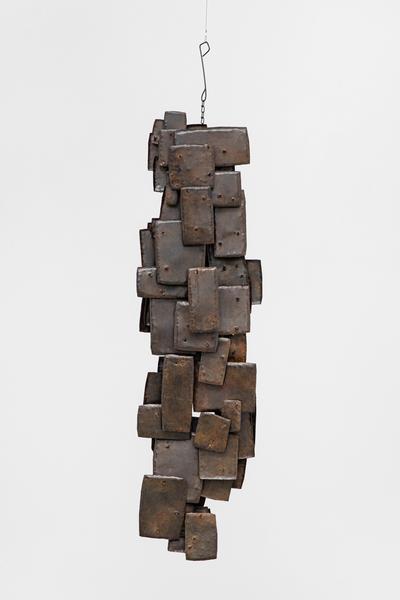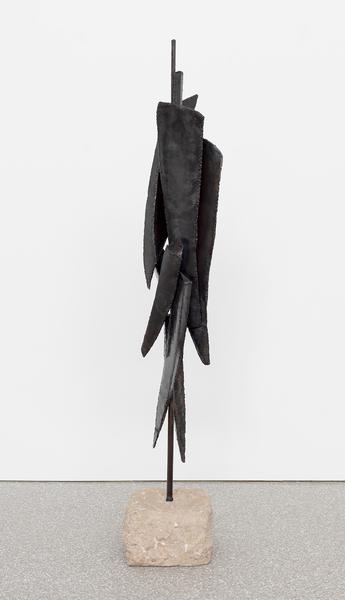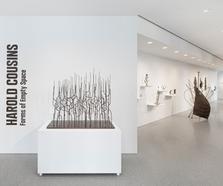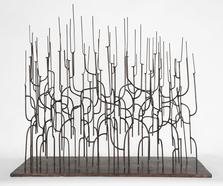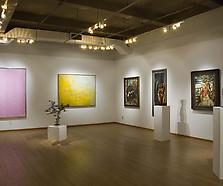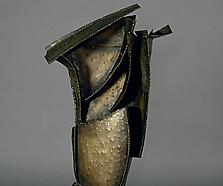“…one might say that art, like science, is a constant probing of the unknown – a seeking. I believe an artist should make art that he feels relevant to his day, taking into account the works of artists of the past. The empty spaces within and around a sculpture pose a challenge that has become for me almost an obsession.”[1]
A sculptor known for his lifelong commitment to bold experiments in metal, Harold Cousins was born in Washington, DC in 1916. Raised in the city’s U-Street neighborhood, Cousins was exposed early on to art by way of the area’s vibrant musical and artistic scene, a cultural hub known as “Black Broadway” which instilled in Cousins an insulation from the detriments of racism and the hopeful prospect of a career in art. Cousins served in the United States Coast Guard during World War II, from 1943 until 1945, and returned to Washington in 1946 to work as a postal employee. He completed an associate’s degree at Howard University in 1947, where he was influenced by the writings of Alain Locke, then head of the Philosophy department. Cousins remained friendly with Locke, whom he considered a mentor. In 1948, he moved to New York City and studied at the Art Students League with William Zorach and Will Barnett. During this time, Cousins met his future wife, fellow sculpture student Peggy Thomas, and developed friendships with Michael Goldberg, William Stanley Hayter and Frank Stella. In 1949, with funding from the GI Bill, Cousins, along with Peggy, left the United States and made his home in Paris, where he worked with the modernist sculptor Ossip Zadkine as one of ten students selected to study privately with him at his studio in Montparnasse.
In Paris, Cousins was captivated by the city’s museums; he frequented the Louvre, especially its Egyptian wing, and the Musée Rodin, dedicated to pioneering French sculptor Auguste Rodin. Cousins also visited the many ethnographic museums; among these, his favorite was the Musée de l’Homme, where he saw sculpture spanning the globe from Africa, Asia, and the Americas. In particular, the mastery of woodworking demonstrated in the African sculptures and masks on display intrigued Cousins, but he was especially inspired by works that combined wood with an array of other materials, which Cousins had already begun to explore in his own work. As he explained, “What especially attracted me was the use of sheaths of metal, often together with nails and chains. These sculptures have a vibrancy that seems to be produced both between the metal elements themselves and between the metal elements and the overall sculptural form.”[2]
In the early 1950s, Cousins learned oxyacetylene welding from sculptor Shinkichi Tajiri, whom he had met during his studies with Zadkine, and his art developed from figurative forms in terracotta and wood, to works that incorporated more and more metal. Finally, Cousins established his mature identity as an abstract sculptor working with welded steel. Enthralled by this new technique, Cousins shared his interest in welding with Zadkine, who rejected the practice and suggested he study sculpture at the Académie de la Grande Chaumière. During this pivotal time, Cousins joined a circle of fellow expatriate artists enrolled at the school that included Beauford Delaney, Ed Clark, Herbert Gentry and Larry Potter.
Inspired also by the work of sculptor Julio González, Cousins created his first welded steel sculpture in 1952, with scrap metal he bought from junkyards along the Seine, and he had his first major exhibition of them two years later at Galerie Raymond Creuze in Paris. Cousins’ early forays into welding were born out of his fascination with “the ‘magic’ of joining together pieces of metal of different shapes.”[3] Some of the first forms that Cousins created with his own metal parts were assemblages of welded steel rods which he called “forests” due to their resemblance to the trunks of trees. While firmly rooted in abstraction, Cousins’ sculptures—as in the “forests”—are often representational, alluding also to figures such as his “warriors”, “musicians”, and “birds”. Cousins designed these linear works as reliefs and standing sculptures that would activate the surrounding space through their three-dimensionality and the interplay of light and shadows created by line, form and varying degrees of transparency. He referred to such experimentations as “drawings in space,” a concept he credited to González.
In 1957, Cousins coined the term plaiton—a synthesis of the English word “plate” and the French “laiton” (brass)—to describe his sculptures of repeated metal plates welded together in a predetermined order. In discussing these works, Cousins once stated that a key part of the process for him involved “giving special attention to the form of the empty space between the solid elements of a sculpture as well as to the empty space surrounding the sculpture.”[4] Cousins continued to work on these large-scale works, further exploring their structural possibilities in orientations horizontal and vertical, by joining plaitons to rods to create variations comprised of different configurations and combinations. In addition to these artistic breakthroughs, the period was significant on a personal level as well: Cousins’ daughter Danielle was born in 1957, followed by his son Marc in 1959. In the early 1960s, the family acquired a home, known as Le Mont Herault, in the Normandy countryside; the immersion in a natural setting would have a profound effect on Cousins’ work.
In 1950, Cousins had his first solo exhibition in Paris at Galerie Huit, an artist-run cooperative associated with, in addition to Tajiri, Sam Francis, Sidney Geist, Al Held, Paul Jenkins, Jonah Kinigstein, Joan Mitchell, Jules Olitski and Haywood “Bill” Rivers, among others. Throughout the 1950s, Cousins subsequently participated in numerous prestigious exhibitions, including the annual presentations of the Salon de la Jeune Sculpture and the Salon des Réalités Nouvelles. He became acquainted with Karel Appel, César, Sonia Delaunay and Michel Seuphor, who also wrote about Cousins’ work. From 1960 until 1967, Cousins was represented by Galerie Karl Flinker while continuing to exhibit with Galerie Creuze alongside Antoni Tàpies, Oscar Chelimsky and other members of the École de Paris, underscoring his important contributions to the evolution of abstraction in postwar Paris.
Throughout the 1950s and 60s, Cousins continued to develop his Plaiton sculptures—evoking the natural world as well as architecture—while beginning to experiment with a return to abstract figurations of the human form. These sculptures were imbued with political and social commentary, embodying personal and cultural specificity as well as a universality of the human condition. Several sculptures, with such titles as Political Prisoner (1954) and Slave (1963), directly reference the civil rights movement in the United States that Cousins experienced and reacted to from abroad. Working in solid, Cubist-style forms that in turn referenced a Futurist-style sense of movement, these works evolved, later on in the 1970s, into his Human Comedy series, linear, puppet-like sculptures that pondered philosophical and existential questions. Cousins explained that these figures came out of the “belief [that] everything we undertake is affected, even manipulated, by forces outside our own control.”[5]
Cousins moved to Brussels, Belgium in 1967, where he worked for the remainder of his life. There, Cousins was the subject of a number of gallery exhibitions and he was represented by Galerie Carrefour. In 1976, the Cultural Center of Woluwe-Saint-Pierre, outside Brussels, organized a retrospective exhibition of his work. Throughout his career, he was celebrated in Europe, completing numerous public commissions and exhibiting actively in Belgium, France and Germany. However, it was not until four years after his death—in 1992—that his artwork was shown in his native country, when The Studio Museum in Harlem mounted its 1996 traveling exhibition, Explorations in the City of Light: African-American Artists in Paris, 1945-65.
Michael Rosenfeld Gallery’s representation of the Estate of Harold Cousins represents a culmination of the commitment and dedication to Harold Cousins’ work and legacy that spans more than two decades. In 1999, the gallery mounted a solo exhibition of the artist’s work: Harold Cousins, The 1950s: Welded Sculpture. The gallery has also included his work in several group exhibitions, including the celebrated series African American Art: 20th Century Masterworks (1998, 1999, 2000); Linear Impulse (1999); Decoding Myth: African American Abstraction, 1945-1970 (2007); African American Art: 200 Years (2008); Abstract Expressionism: Further Evidence (Part Two: Sculpture) (2009); Abstract Expressionism: Reloading the Canon (2011); Beyond the Spectrum: Abstraction in African American Art, 1950-1975 (2014); METAL: American Sculpture, 1945-1970 (2016) and Globalism Pops BACK Into View: The Rise of Abstract Expressionism (2019). In 2023, Michael Rosenfeld Gallery presented the solo exhibition, Harold Cousins: Forms of Empty Space, the first solo exhibition of the artist’s work in the United States in fifteen years and the gallery’s first exhibition dedicated to Cousins since taking on representation of the artist’s estate in 2020.
In the past twenty years, Cousins’ work has been shown in such group exhibitions as Western Neolithic Idols: Symbols of Fertility and Life, Loyola University Museum of Art, Loyola University, Chicago, IL (2009); Artists in Exile: Expressions of Loss and Hope, Yale University Art Gallery, Yale University, New Haven, CT (2017) and Riffs and Relations: African American Artists and the European Modernist Tradition, The Phillips Collection, Washington, DC (2020). In 2024, Cousins’ sculpture La Forêt (c.1960) was featured in the acclaimed exhibition Americans in Paris: Artists Working in Postwar France, 1946-1962 at New York University’s Grey Art Museum, New York, NY, traveling to the Addison Gallery of American Art in Andover, MA later that year.
Harold Cousins’ work can be found in museum collections worldwide including the Bibliotheque Royale, Brussels, Belgium; Birmingham Museum of Art, Birmingham, AL; Centre National d’Art Contemporain, Paris, France; Cogi France, Paris, France; Etat Belge, Nederland Culture, Belgium; Howard University Gallery of Art, Washington, DC; Lehmbruck Museum, Duisburg, Germany; Maison de la Culture, Wolusé-st-Pierre, Belgium; The Metropolitan Museum of Art, New York, NY; Middleheim Museum, Brussels, Belgium; Middleheim Museum, Antwerp, Belgium; Modern Art Museum, Brussels, Belgium; Modern Museum of Art, Kassel, Germany; Musée d’Art Moderne, Paris, France; Musée de St. Etienne, Paris, France; Museum Haus Lange, Germany; Sidney and Lois Eskenazi Museum of Art at Indiana University; and the Yale University Art Gallery, New Haven, CT.
Michael Rosenfeld Gallery LLC is the exclusive representative of the Estate of Harold Cousins.
[1] Harold Cousins, “‘Plaiton’ Sculpture: Its Origin and Developments,” Leonardo vol. 4, no. 4, Fall 1971, 353.
[4] Ibid.
[5] Cousins, quoted in Rona Dobson, “La comédie humaine d’Harold Cousins,” Harold Cousins: La Comédie Humaine (Brussels: Galerie Rencontre, c.1977), n.p.


